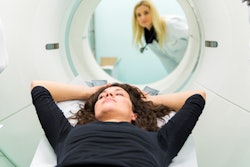
PET is significantly more proficient than SPECT in detecting severe obstructive coronary artery disease (CAD), enabling more appropriate use of revascularization treatment, according to a study presented on Saturday at the American College of Cardiology (ACC) meeting in Orlando, FL.
After transitioning from technetium-99m (Tc-99m) SPECT to rubidium (Rb-82) PET for diagnosing obstructive CAD, the Intermountain Medical Center Heart Institute in Salt Lake City experienced a greater percentage of high-grade CAD diagnoses and subsequent revascularizations. Intermountain researchers documented the difference in clinical outcomes by imaging modality in a study involving more than 10,000 patients.
"Our findings represent one of the largest PET cohorts studied to date and reinforce that PET is better than SPECT at risk-stratifying patients for significant coronary artery disease," said lead author Dr. David Min, a cardiologist at Intermountain. "[The study] also demonstrated that by transitioning to PET-based programming, it can lead to fewer false-positive and false-negative studies; that is, less patients getting invasive procedures they don't need, but increasing the percentage of patients who benefit from needing invasive procedures following PET."
Transitioning to PET
Although both PET and SPECT provide metabolic and functional information about the heart, cardiac PET achieves better image resolution and quality. PET is not as widely available, however.
Still, PET's ability for diagnosing and assessing suspected CAD gained attention in an August 2017 study by Dutch researchers, who wrote that the "choice of noninvasive testing for a diagnosis of significant coronary artery disease is ambiguous." In a head-to-head comparison, PET outperformed SPECT, coronary CT angiography (CCTA), and hybrid variations of the three modalities in patients with myocardial ischemia. Interestingly, combining CCTA with SPECT or PET did not improve the detection of CAD among these symptomatic patients.
Despite similar results in other previous studies, SPECT still remains the modality of choice for the majority of imaging practices, however.
"There are a variety of reasons why SPECT remains the predominant nuclear myocardial perfusion imaging stress test despite the known benefits of PET," Min wrote in an email to AuntMinnie.com. "The largest reason is that SPECT remains more widely available compared to PET, given that SPECT has been around longer. It does not appear that the availability of rubidium is a limiting factor."
Clinicians at Intermountain began to transition from SPECT to PET in 2013 for a number of reasons, including the modality's superior image quality, higher sensitivity, and decreased radiation exposure, Min noted.
To understand the differences in clinical outcomes for patients receiving SPECT or PET, the researchers conducted a retrospective analysis of catheterization outcomes 60 days after heart patients received various treatments. They analyzed the rate of coronary angiography procedures within 60 days, the incidence of high-grade obstructive CAD, and rates of revascularization.
PET vs. SPECT
After reviewing Intermountain data, the researchers identified 3,394 patients who underwent a Tc-99m SPECT scan in 2011 and 2012 and 7,478 patients who underwent Rb-82 PET imaging in 2014 and 2015. The subjects had an average age of 65 years (± 12.9 years) and were fairly evenly divided in terms of gender (53% male, 47% female).
| Clinical outcomes by modality | ||
| Tc-99m SPECT | Rb-82 PET | |
| Diagnosis rate for severe obstructive CAD | 70% | 79% |
| Patients who underwent angiography within 60 days | 11% | 14% |
| Patients who received revascularization | 43% | 55% |
All differences were statistically significant (p < 0.001) for diagnosis rates and for angiography and revascularization rates (p < 0.0001).
What's more, the odds of obstructive CAD (p = 0.005) and revascularization (p = 0.0006) remained higher for patients who received PET studies, and these higher odds were maintained in patients without prior CAD or myocardial infarction, according to the researchers.
Why the vast difference between the modalities? Min cited the respective tracers -- rubidium-82 and technetium-99m -- as contributing factors.
"The use of a positron-emitter, such as rubidium, allows for higher-quality images, quantification of myocardial blood flow, and shorter scan times," he explained.
Future research
To validate the results, Min and colleagues recommended additional analysis of the long-term clinical and financial effects of cardiac PET. They also would like to pursue additional research regarding cardiac PET and other imaging modalities and treatment algorithms.
"We will continue to follow the clinical outcomes of patients in this study, as well as perform a cost-effectiveness analysis, as this may impact decisions of other health systems as they examine the high value of cardiac PET and downstream resource utilization," Min said.
So far, though, the current findings have broad implications for physicians considering what test best serves their individual patients, as well as for institutions who are weighing the advantages and disadvantages of cardiac SPECT and PET myocardial perfusion imaging, according to Min.
He also noted that patients and healthcare providers need more education on the differences in these stress tests.
"Further training and research is needed in cardiac PET that will increase adoption of the modality and improve the quality of the studies and their interpretation," he said.




















